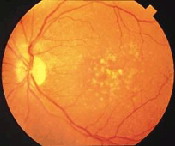
Since November 2010, I have been following Advanced Cell Technology’s (ACT) quest to implement successful clinical trials for macular eye disease, using human embryonic stem cells. ACT’s U.S. and European Phase I/II clinical trials each involve a total of 12 patients, in groups of three (also called cohorts). The first group/cohort received a dosage of 50,000 cells, the second will receive 100,000 cells, the third will receive 150,000 cells and the final group/cohort will be dosed with 200,000 cells.
ACT also has announced that Scotland’s NHS Lothian will be an additional site for their European clinical trial for Stargardt’s disease. Here is a recap of ACT’s progress to date:
The Most Recent Clinical Trials
ACT has secured approval to proceed with the increased 100,000-cell dosage to the second patient groups/cohorts of both the Stargardt’s disease and dry age-related macular degeneration (AMD) clinical trials.
On November 28, 2012, ACT announced the treatment of the fifth and sixth patients in the company’s Phase I/II clinical trial for dry AMD, completing the second patient group/cohort. The fifth patient was treated at Massachusetts Eye and Ear Infirmary, a Harvard Medical School affiliate, by a surgical team led by Dean Eliott, M.D., a retina surgeon and associate director of the Retina Service. Also, the sixth patient in ACT’s clinical trial for Stargardt’s disease was treated, completing the second Stargardt’s group/cohort.
Moorfields Eye Hospital
On July 27, 2012, ACT announced the treatment of the third patient in its European Phase I/II clinical trials for Stargardt’s disease, using retinal pigment epithelial (RPE) cells derived from human embryonic stem cells. The most recent surgery was performed at Moorfields Eye Hospital in London, England by a surgical team led by Professor James Bainbridge, consultant surgeon at Moorfields and Chair of Retinal Studies at University College London. The first patient was treated on January 20, 2012, and the second on June 29, 2012.
Wills Eye Institute
On February 15, 2012, ACT announced that Wills Eye Institute in Philadelphia received institutional review board (IRB) approval as a site for ACT’s Phase I/II clinical trial for Stargardt’s disease. In January, ACT also announced that the IRB at Wills had approved the participation of the institution as a site for ACT’s clinical trial for dry AMD.
On July 11, 2012, ACT announced the treatment of the fourth patient (the first in the second patient cohort) in its U.S. clinical trial for Stargardt’s disease. The surgery was performed by a surgical team led by Carl D. Regillo, MD, FACS, director of the Wills Eye Clinical Retina Research Unit, attending surgeon in the Wills Eye Retina Service at the Wills Eye Institute, and professor of ophthalmology at Thomas Jefferson University. The Wills patient was injected with 100,000 cells, compared with the 50,000-cell dose used in the previous trial.
On August 12, 2012, Dr. Regillo treated the fourth patient (the first in the second patient cohort, also receiving a 100,000-cell dosage) in the Phase I/II clinical trial for dry AMD.
Jules Stein Eye Institute
On July 12, 2011, ACT announced the treatment of the first two patients in its Phase I/II clinical trials for Stargardt’s disease and dry AMD. The procedures were carried out by principal investigator Steven Schwartz, M.D., Ahmanson Professor of Ophthalmology at the David Geffen School of Medicine and retina division chief at the Jules Stein Eye Institute, both at UCLA. On January 24, 2012, Dr. Schwartz treated the second patient in the Phase I/II trial for Stargardt’s disease.
Additional Background Information
To better understand this latest development, here is background information from my prior blog posts about ACT’s initial stem cell clinical trial for Stargardt’s disease and its subsequent clinical trial for dry age-related macular degeneration:
On November 22, 2010, the U.S. Food and Drug Administration (FDA) lifted a prior clinical hold on stem cell research to clear Advanced Cell Technology’s Investigational New Drug (IND) application and initiate a Phase I/II multicenter study, using retinal cells derived from human embryonic stem cells to treat patients with Stargardt’s disease.
ACT’s product is a human embryonic stem cell trained to become a retinal cell. ACT first requested approval from the FDA to conduct the clinical trial approximately one year ago.
On January 3, 2011, ACT announced that they had received FDA clearance for yet another new clinical trial, this time using embryonic stem cells to treat dry AMD.
What Is the Future of the Stem Cell Clinical Trials?
From Gary Rabin, Chairman and CEO of ACT:
“We are excited with the developments we have seen in our U.S. and European trials and continue to accelerate enrollment in our clinical programs. We believe that these three trials could represent a paradigm shift in the way that stem cells are used in medicine and are pleased by the support we have received from our clinical trial site partners.”
From Robert Lanza, M.D., ACT’s chief scientific officer:
“Using high resolution imaging technology, we have been observing evidence indicating that the transplanted RPE cells are getting to the right place in the sub-retinal space, engrafting and are apparently resurfacing areas of the retina with a new RPE layer. With multiple follow-ups happening across multiple trial sites with these patients, we also continue to see an encouraging trend with respect to subjective and objective observations relating to visual acuity, color perceptions and contrast in vision. In the case of the first dry AMD and [Stargardt’s disease] patients, the visual acuity gains we saw more than a year ago continue to persist.”
VisionAware will continue to track stem cell research and provide updates as they become available.